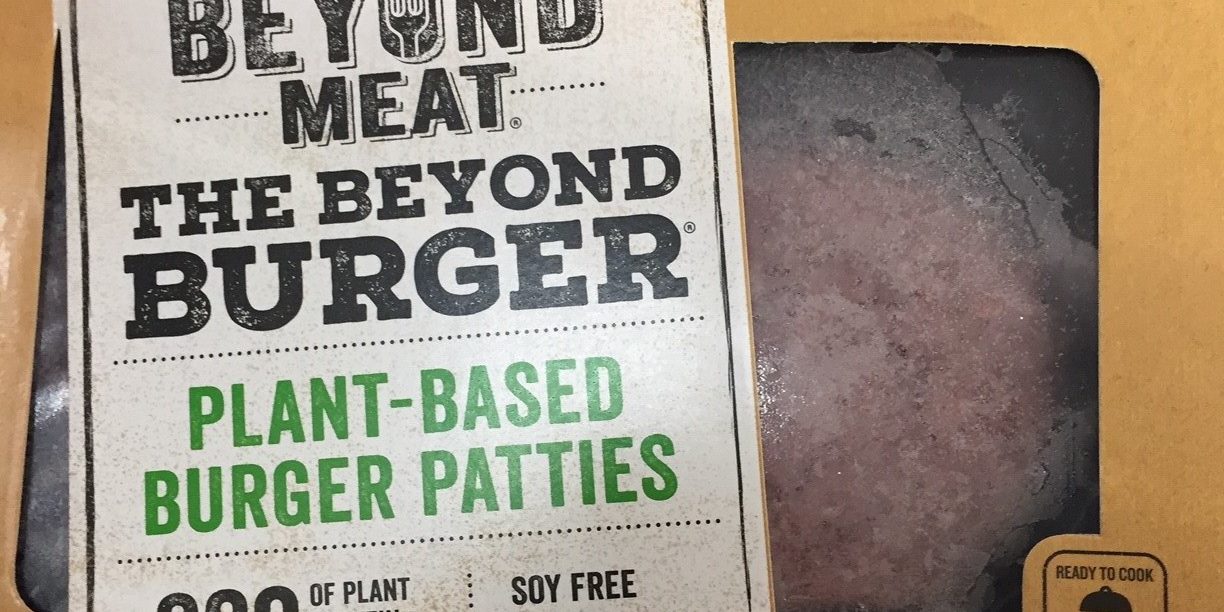As a part of my cell-based meat blog series, I have read many, many articles about the virtues and vices of animal meat, cell-based meat and plant-based meat. I became relatively familiar with companies like JUST, Impossible Burgers, and Beyond Meat. I consumed so much media about them that when I saw Beyond Meat’s Beyond Burger in my normal grocery store, I felt compelled to try it.

I added it to my grocery cart and went on my merry way. It was more expensive than your typical pre-formed hamburger patty ($2.24 per hamburger patty compared to $3.49 per Beyond Burger patty). It would be even cheaper if you just bought ground beef and formed the patty yourself. You can tell from the texture that it was not hamburger meat, but it does look awfully close. The red coloring looked much closer to beef than other plant-based burgers, which are usually a shade of green or brown.
Do Not Overcook
The cooking instructions were pretty simple: pre-heat grill or pan to medium-high to high heat and cook for 3 minutes per side. It was still cold outside here in Virginia, and I was not about to go outside to grill this burger, so I cooked it in a skillet.
The package was clear that the inside of the burger would remain red. I usually like burgers either medium or medium rare, so this did not concern me, but I had assumed that the outside of the burger would brown. Which it did, but it took longer than I expected, and I definitely cooked it longer than the recommended 3 minutes per side. It looked like a burger, so I cooked it like a burger. I ended up burning it waiting for the sides to brown before I remembered that this was a vegetarian patty, not a beef patty, and it would not necessarily cook the same way. Once the smoke alarm went off, I decided the patty was done, red or not.
Taste and Texture
Now the part I was most curious about: taste, texture, appearance. Given that I did overcook the patty, the texture and taste may have been different from a properly cooked Beyond Burger. The color, as I mentioned, was a bit red. The texture was what you would expect from a plant-based burger, if you have had other ones before. Another note: I did not eat this burger patty as burger (with a bun, ketchup or mustard, pickles, etc). I ate the patty just as it was. This may have made the differences more noticeable than if you had it in a Whopper.
Nutrition
Although it had 20 grams of protein per serving, the Beyond burger also had 20 grams of fat. Which, when multiplied by 9 calories per gram, leaves us with 180 calories from fat (though the label says 170), making up 64% of the patty’s total calories (270). I suspect most of this comes from the canola oil and coconut oil. Compare this with a 93% lean beef hamburger, which has 8 grams of fat, 70 calories from fat, 41% of total patty calories (170).

I think this is an important point: just because something is made with vegetables does not mean it is healthy. The protein comes from pea isolate – different from eating peas, like eating white bread is different from eating whole wheat. Yes, it came from the same place, but you’ve lost something along the way.
It is true that a beef patty will have more cholesterol than a plant-based patty. However, dietary cholesterol has very little impact on blood cholesterol levels. This is because cholesterol in the body is highly regulated. If you consume more cholesterol, your body will produce less. Our bodies require more cholesterol than the average person consumes in a day, so your body will still be producing cholesterol to fill that gap.
Conclusion
As an imitation, the Beyond Burger was excellent. My overcooking it is proof of that. However, if you are someone who appreciates a really good hamburger (the type you expect from a place that asks you how you want it cooked), this plant-based alternative does not meet expectations. If you are thinking about switching out a beef burger for a Beyond burger for health reasons, you may be disappointed.
All posts are the opinion of the author and do not necessarily represent the view of the Animal Ag Alliance.







